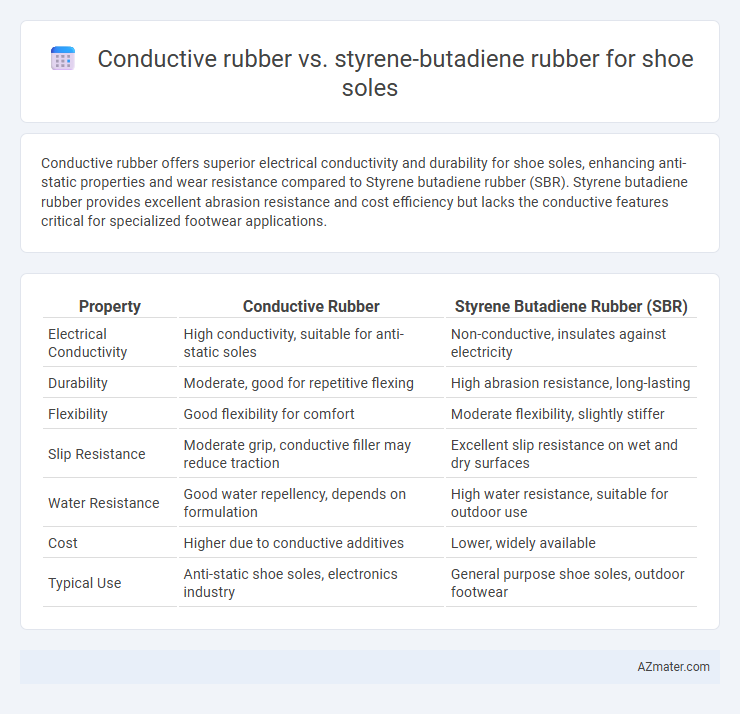Conductive rubber offers superior electrical conductivity and durability for shoe soles, enhancing anti-static properties and wear resistance compared to Styrene butadiene rubber (SBR). Styrene butadiene rubber provides excellent abrasion resistance and cost efficiency but lacks the conductive features critical for specialized footwear applications.
Table of Comparison
| Property | Conductive Rubber | Styrene Butadiene Rubber (SBR) |
|---|---|---|
| Electrical Conductivity | High conductivity, suitable for anti-static soles | Non-conductive, insulates against electricity |
| Durability | Moderate, good for repetitive flexing | High abrasion resistance, long-lasting |
| Flexibility | Good flexibility for comfort | Moderate flexibility, slightly stiffer |
| Slip Resistance | Moderate grip, conductive filler may reduce traction | Excellent slip resistance on wet and dry surfaces |
| Water Resistance | Good water repellency, depends on formulation | High water resistance, suitable for outdoor use |
| Cost | Higher due to conductive additives | Lower, widely available |
| Typical Use | Anti-static shoe soles, electronics industry | General purpose shoe soles, outdoor footwear |
Introduction to Rubber Types for Shoe Soles
Conductive rubber and styrene butadiene rubber (SBR) serve distinct functions in shoe sole manufacturing due to their differing properties. Conductive rubber offers excellent electrical conductivity, making it suitable for anti-static or ESD protective footwear. Styrene butadiene rubber provides superior abrasion resistance and flexibility, commonly used for durable, slip-resistant soles in everyday and athletic shoes.
What is Conductive Rubber?
Conductive rubber is a specialized elastomer embedded with conductive fillers such as carbon black or metal particles to enable electrical conductivity, making it ideal for anti-static shoe soles. Unlike styrene butadiene rubber (SBR), which offers excellent abrasion resistance and flexibility but lacks inherent conductivity, conductive rubber prevents static buildup and dissipates electric charges safely. Its application in shoe soles enhances safety in electronic manufacturing environments and cleanrooms where electrostatic discharge (ESD) protection is critical.
What is Styrene Butadiene Rubber (SBR)?
Styrene Butadiene Rubber (SBR) is a synthetic rubber commonly used for shoe soles due to its excellent abrasion resistance, flexibility, and cost-effectiveness. Compared to conductive rubber, which is engineered to provide electrical conductivity for anti-static or electromagnetic applications, SBR offers superior durability and cushioning properties essential for everyday footwear. Its polymer structure, combining styrene and butadiene monomers, delivers enhanced resilience against wear, making it a preferred choice in the shoe industry.
Key Material Properties: Conductive Rubber vs SBR
Conductive rubber offers excellent electrical conductivity due to the integration of conductive fillers like carbon black or graphite, making it ideal for anti-static or electromagnetic shielding applications in shoe soles. Styrene butadiene rubber (SBR) provides superior abrasion resistance, flexibility, and cost-effectiveness, commonly used for durable, non-conductive shoe soles. While conductive rubber excels in electrical performance, SBR is preferred for mechanical durability and wear resistance in footwear manufacturing.
Electrical Conductivity: Importance in Footwear
Conductive rubber enhances footwear safety by enabling static dissipation, reducing the risk of electric shock or damage to sensitive electronic devices. Styrene butadiene rubber (SBR), commonly used for shoe soles, offers durability and flexibility but lacks inherent electrical conductivity, limiting its protective capabilities. Incorporating conductive fillers like carbon black into SBR can improve electrical conductivity, making it more suitable for specialized footwear in static-sensitive environments.
Durability and Wear Resistance Comparison
Conductive rubber offers excellent electrical conductivity combined with high abrasion resistance, making it ideal for anti-static shoe soles in industrial environments. Styrene butadiene rubber (SBR) exhibits superior wear resistance and overall durability in everyday footwear due to its strong tensile strength and aging stability. While conductive rubber excels in specialized applications requiring conductivity, SBR outperforms in long-term durability and resistance to wear under typical walking and running conditions.
Comfort and Flexibility in Shoe Soles
Conductive rubber provides superior flexibility and shock absorption, enhancing overall shoe sole comfort by adapting closely to foot movements. Styrene butadiene rubber (SBR) offers durability and high abrasion resistance but tends to be stiffer, which can reduce flexibility and lessen comfort during prolonged wear. For applications prioritizing comfort and flexibility in shoe soles, conductive rubber is generally preferred due to its elastic and cushioning properties.
Slip Resistance and Traction Performance
Conductive rubber and styrene butadiene rubber (SBR) differ significantly in slip resistance and traction for shoe soles. Conductive rubber offers enhanced slip resistance due to its unique electrical conductivity properties, which help dissipate static electricity and improve grip on smooth or oily surfaces. In contrast, SBR provides reliable traction in dry conditions but may underperform on wet or slippery surfaces, making conductive rubber a superior choice for slip-resistant shoe soles in hazardous work environments.
Cost Effectiveness and Manufacturing Considerations
Conductive rubber offers superior electrical conductivity and durability for shoe soles but tends to be more expensive due to specialized material formulations and processing requirements. Styrene butadiene rubber (SBR) provides a cost-effective alternative with good abrasion resistance and ease of manufacturing through established molding techniques, making it suitable for high-volume production. Manufacturers must balance the higher material and production costs of conductive rubber against the economic efficiency and scalability of SBR based on the specific performance needs of the footwear.
Best Applications: Choosing the Right Rubber for Your Shoe Soles
Conductive rubber is ideal for shoe soles requiring anti-static properties and electrical conductivity, making it perfect for environments like electronics manufacturing or cleanrooms. Styrene butadiene rubber (SBR) excels in general-purpose soles due to its excellent abrasion resistance, durability, and cost-effectiveness, suitable for everyday footwear and casual shoes. Selecting between conductive rubber and SBR depends on whether electrical conductivity or durability and affordability are the priority for the intended shoe application.

Infographic: Conductive rubber vs Styrene butadiene rubber for Shoe sole
 azmater.com
azmater.com